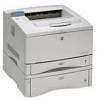HP 5100tn Printer Job Language - Technical Reference Manual - Page 4
Manual, Organization - laserjet parts manual
 |
View all HP 5100tn manuals
Add to My Manuals
Save this manual to your list of manuals |
Page 4 highlights
Manual Organization iv This manual is comprised of ten chapters and four appendices. The first three chapters introduce you to the range of PJL features, PJL syntax and format, some rules about using PJL, and a brief description of each command. Chapter 4 explores the essential "kernel" commands-those commands that are part of almost every PJL job. Chapters 5 through 9 each describe a separate group of related commands. The remaining chapters cover programming tips and related PJL information. A brief description of each chapter is provided below. Chapter 1. Introduction to PJL This chapter explains what PJL is, who should use PJL, and the benefits of using PJL in application programs. It also covers compatibility with non-PJL printers, which includes HP LaserJet printers, HP DeskJet printers, and HP DesignJet plotters and printers. Chapter 2. PJL Command Syntax and Format Chapter 2 explains the conventions used to describe PJL command syntax. The chapter also explains the formats that PJL commands follow and describes what happens when the printer receives an illegal command. Chapter 3. Using PJL This chapter explains how PJL commands are used, including the requirements of a PJL job and examples showing basic PJL command structure. In addition, the chapter categorizes the PJL commands in this manual by their functionality, along with a brief command summary. Chapter 4. Kernel Commands This chapter explains the three core commands used in most PJL jobs: the Universal Exit Language (UEL) command, the COMMENT command, and the ENTER command. The chapter also describes the related topics of implicit and explicit printer language switching.













